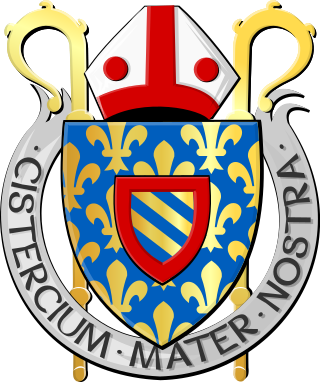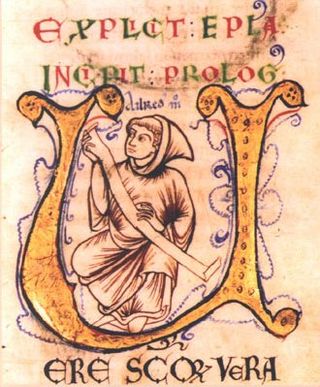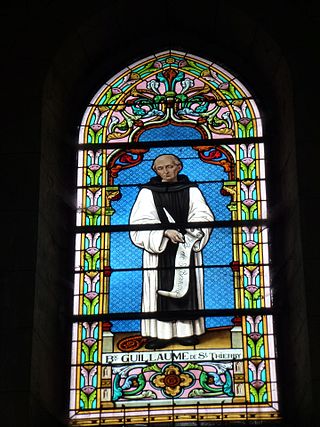
Bernard of Clairvaux, O. Cist., venerated as Saint Bernard, was an abbot, mystic, co-founder of the Knights Templar, and a major leader in the reform of the Benedictines through the nascent Cistercian Order.

Clairvaux Abbey was a Cistercian monastery in Ville-sous-la-Ferté, 15 kilometres (9.3 mi) from Bar-sur-Aube. The original building, founded in 1115 by Bernard of Clairvaux, is now in ruins; the bulk of the present structure dates from 1708. Clairvaux Abbey was a good example of the general layout of a Cistercian monastery. The abbey has been listed since 1926 as a historical monument by the French Ministry of Culture.

The Cistercians, officially the Order of Cistercians, are a Catholic religious order of monks and nuns that branched off from the Benedictines and follow the Rule of Saint Benedict, as well as the contributions of the highly-influential Bernard of Clairvaux, known as the Latin Rule. They are also known as Bernardines, after Saint Bernard himself, or as White Monks, in reference to the colour of the "cuculla" or cowl worn by the Cistercians over their habits, as opposed to the black cowl worn by Benedictines.

Aelred of Rievaulx, O Cist., also known as also Ailred, Ælred, or Æthelred; was an English Cistercian monk and writer who served as Abbot of Rievaulx from 1147 until his death. He is venerated by the Catholic Church as a saint and by some Anglicans.

Malachy is an Irish saint who was Archbishop of Armagh, to whom were attributed several miracles and an alleged vision of 112 popes later attributed to the apocryphal Prophecy of the Popes.

Cistercian architecture is a style of architecture associated with the churches, monasteries and abbeys of the Roman Catholic Cistercian Order. It was heavily influenced by Abbot Bernard of Clairvaux, who believed that churches should avoid superfluous ornamentation so as not to distract from prayer. Cistercian architecture was simple and utilitarian. Although a few images of religious subjects were allowed, such as the crucifix, elaborate figures common in medieval churches were prohibited. Bernard noted their capacity for distracting monks in a famous letter. Early Cistercian architecture shows a transition between Romanesque and Gothic architecture. Later abbeys were constructed in Renaissance and Baroque styles, which were more ornate by nature.

Mount St Bernard Abbey is a Roman Catholic monastery belonging to the Trappist Order, near Coalville, Leicestershire, England, founded in 1835 in the parish of Whitwick and now in that of Charley. The abbey was the first permanent monastery to be founded in England since the Reformation and is the sole Trappist house in England. The monks brew the only Trappist beer in Britain.

William of Saint-Thierry, O. Cist was a twelfth-century Benedictine, theologian and mystic from Liège who became abbot of Saint-Thierry in France, and later joined the Cistercian Order.
Geoffrey of Clairvaux, or Geoffrey of Auxerre, was the secretary and biographer of Bernard of Clairvaux and later abbot of a number of monasteries in the Cistercian tradition.

Raoul, founder of Vaucelles Abbey or Saint Raoul is a saint of the Catholic Church who founded the famous monastery of Vaucelles in France. Raoul was an English Benedictine monk who became a follower of St. Bernard of Clairvaux.

Arcis-le-Ponsart is a commune in the Marne department in northeastern France. It is located along the D25 road, south of Courville, 32.2 kilometres (20.0 mi) by road southwest of Reims. The commune of Arcis-le-Ponsart has an area of 15.4 square kilometres (5.9 sq mi). The local economy is mainly agricultural based. Igny Abbey lies in this commune.

Hugh of Noara or of Novara, also known as Ugo of Novara and Hugo of Novara, was a Cistercian monk and a disciple of Bernard of Clairvaux. French by birth, he served as the first abbot of Novara Abbey, Sicily, where he remained until his death in 1170.
John of Ford was the prior of the Cistercian monastery of Forde, then from 1186 abbot of its daughter house of Bindon, and between 1191 and 1214 the abbot of Forde. He was a friend and ally of King John during the papal interdict, receiving remuneration from the king. While prior he wrote a biography of the local anchorite Wulfric of Haselbury, and while abbot he completed the series of sermons on the Song of Songs begun by Bernard of Clairvaux and continued by Gilbert of Hoyland with 120 sermons on his own from the fifth chapter through the end of the book. In the centuries after his death in 1214, however, John of Ford was almost entirely forgotten. His 120 sermons survive in only a single manuscript.
Stephen of Lexington, was an English Cistercian monk, abbot, and founder of a college in Paris.

Igny Abbey or Val d'Igny Abbey is a Cistercian abbey located in Arcis-le-Ponsart, Marne, France. It was founded in 1128 for Cistercian monks, dissolved in 1791 during the French Revolution, re-established in 1876 for Trappist monks, destroyed in 1918, reopened in 1929 for Trappist nuns and modernised in 2008–12 to accommodate three or four pre-existing communities.
Nicholas of Clairvaux, also Nicholas of Montiéramey was a French Benedictine monk who later became a Cistercian monk. He was a secretary of Saint Bernard of Clairvaux, and the author of letters and sermons.

Blessed Gerard of Clairvaux was the sixth abbot of Clairvaux. He was murdered by a rebellious monk and is counted as the first Cistercian martyr.

Amadeus of Lausanne, O.Cist was a French Cistercian monk, abbot of Hautecombe Abbey and the twenty-third Bishop of Lausanne.
Augustin Marre was a French Roman Catholic Archbishop, and Trappist abbot.
Peter Monoculus was a Cistercian monk who served as the abbot of Igny (1169–1179) and Clairvaux (1179–1185).














